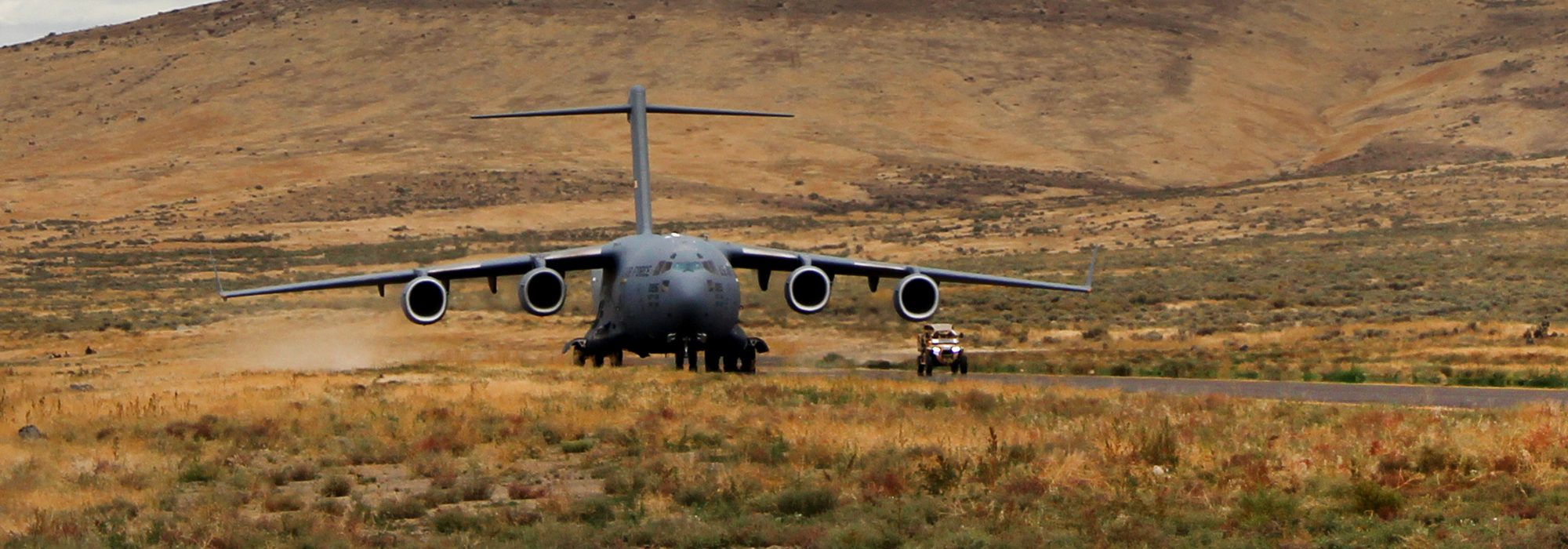FAIRCHILD AFB, Wash.—
In the rolling mountains and plains of the Inland Northwest, thousands of airmen and dozens of aircraft practiced mobility operations in September on an unprecedented size and scale. For three weeks, AMC airmen and aircraft joined with service members and civilians representing the other US military services and 29 international partners to fight their way through a simulation in which adversaries threatened both aircraft and bases. The objective: Learn how to be more agile in the face of adversaries seeking to disrupt USAF operations at every level.
“We are looking at—from the mobility air forces lens—what can we do to be able to adjust where we operate, to reposition where we operate, and to have a lighter, faster footprint” explained Lt. Col. Joseph Monaco, director of Mobility Guardian 2019, the second iteration of this exercise, and the deputy division chief for AMC’s training directorate.
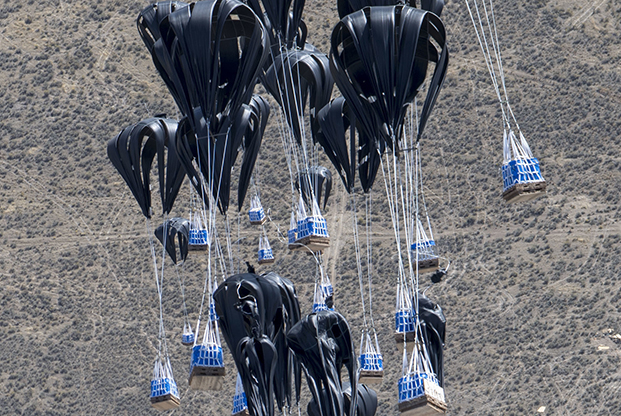
AMC is trying to reinvent itself as a “warfighting command” following changes made atAir Forces Central Command, US Air Forces in Europe-Air Forces Africa, and Pacific Air Forces.
As a result, AMC is now a joint and combined forces air component command, providing direct coordinating authority and providing its own operational command and control, AMC’s Commander Gen. Maryanne Miller said.
“The future of warfare will be increasingly joint and coalition, trans-regional and fast, and will require us to act with greater speed and precision,” Miller said. “This transformation has enabled better integration into joint operations, we’re more responsive to the combatant commanders and we’re able to position our mobility forces to defeat, deter, and win with more speed and agility. In line with this transformation into a warfighting headquarters, we are preparing for full-spectrum conflict with exercises like Mobility Guardian.”
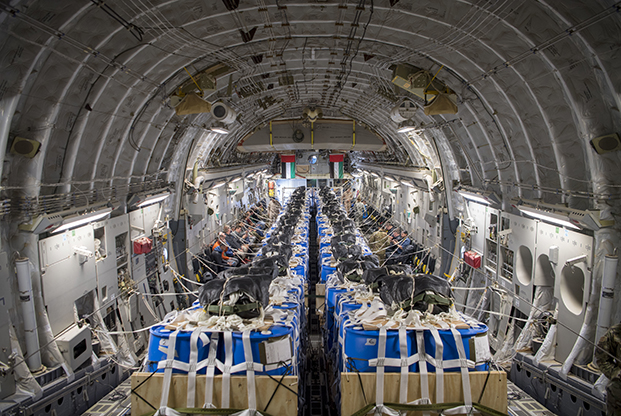
The first night of the exercise saw dozens of aircraft and hundreds of personnel fighting to seize an airfield. A constellation of bases across the western US contributed to the fight, with Fairchild serving as the main forward operating location—much like Al Udeid AB, Qatar, hosts the bulk of aircraft for current Middle East operations.
An Air Operations Center at Travis AFB, Calif., organized and controlled the infiltration, which saw five C-17s fly to Pope Field, N.C., to pick up 500 82nd Airborne troops and deliver them to an “enemy-held” strip at the Yakima Training Center in central Washington. The long, cross-country flight replicates the kind of trek forces would take from the US to a foreign battlefield.
As they approached their destination, those aircraft joined up with two more C-17s, loaded with materiel, which lifted off from Fairchild. Twenty minutes behind them were seven USAF C-130s, plus two more from Canada and one from the US Marine Corps, carrying USAF air mobility liaison officers and other personnel to help stand up airfield operations.
Also joining in: an escort of US Navy E/A-18G Growlers from NAS Whidbey Island, Wash., A-10s and F-15Es from Mountain Home Air Force Base and the Air National Guard’s Gowen Field in Idaho, plus KC-135s launching out of Fairchild and KC-10s from Travis.
Simulated integrated air defense systems firing at the fleet from the Mountain Home Range Complex forced the airlifters to fly in low, maneuvering through simulated countermeasures to deliver troops and equipment to the landing zone under a cloudy midnight sky.
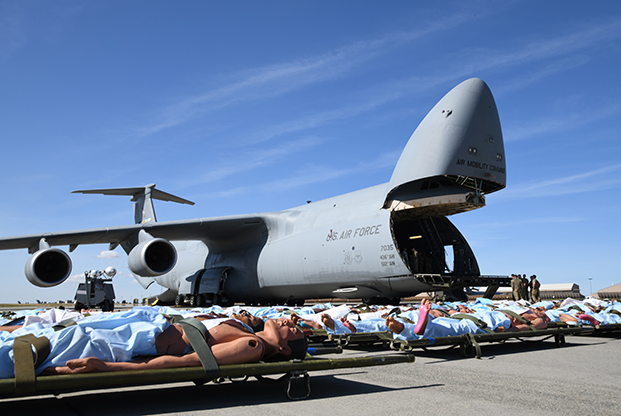
As the aircraft opened their doors for airdrops, an opposing ground force waited to attack. The 10-ship C-17 flight flew repeated passes in the dark, and 500 soldiers parachuted onto rough terrain—some sustaining injuries—before the soldiers fought off the opposition to seize and secure the airstrip. Embedded with the paratroopers were air mobility liaison officers responsible for coordinating between AMC and the Army and to begin airfield operations.
“As AMLOs, we are leaner, lighter. We can go in as a single person,” said Maj. A. J. Baker, the operating location chief with the 621st Mobility Support Operations Squadron. “We go in as the eyes and ears.”
Two C-130s followed with small contingency response airfield assessment teams—called Alpha Mikes because of the last two letters of the team’s unit code—who had just four hours to assess the safety of the field and the airstrip’s condition before follow-on C-17s arrived with more contingency response airmen.
Air Force Magazine accompanied the C-130s on a rehearsal flight on Sept. 12. The C-130s flew in a row, dropping low as they moved into range. The airlifters banked hard and rapidly changed altitude to avoid the simulated IADS before making their way to the drop zone. After the airdrops, the aircraft returned to Fairchild and prepared to ferry equipment to the captured airfield.
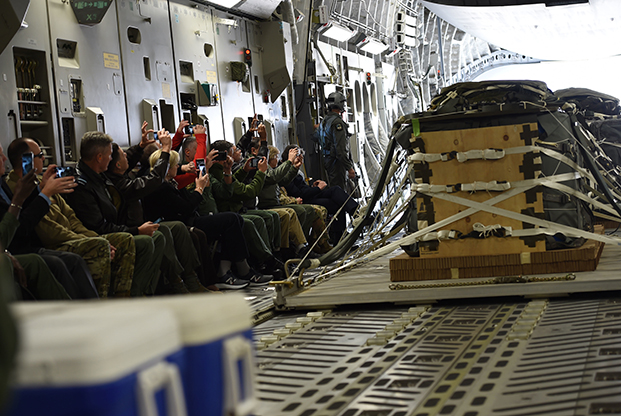
AMC’s “tip of the spear” airmen said they had never trained at this scale before. USAF contingency response airmen worked with an Australian contingency response element, along with other representatives of the “Five Eyes” intelligence alliance—Australia, Canada, New Zealand, the UK, and the US.
“It’s a chance to train like we fight for all of our units,” said Lt. Col. Scott Taylor, the director of operations for the 821st Contingency Response Squadron. “We expect all of our units to maintain the same level of readiness, to be able to do this at any time.”
Following that joint forcible-entry scenario, the exercise shifted its focus—practicing aeromedical evacuation on a grand scale. US and international partners, flying on each other’s aircraft, practiced loading up as many wounded in as little time as possible onto a host of aircraft, including a C-5M Super Galaxy set up to carry almost 100 injured troops.
“We stress that [aeromedical evacuation] system in this exercise, to a great degree,” Miller said. “We gave them mass casualties, with no time to triage, no time to wait for an extra airplane. That is something we never practice—this is the first time we’ve done this, those kind of real-world contingencies that we never get around to, that we know we’re going to face.
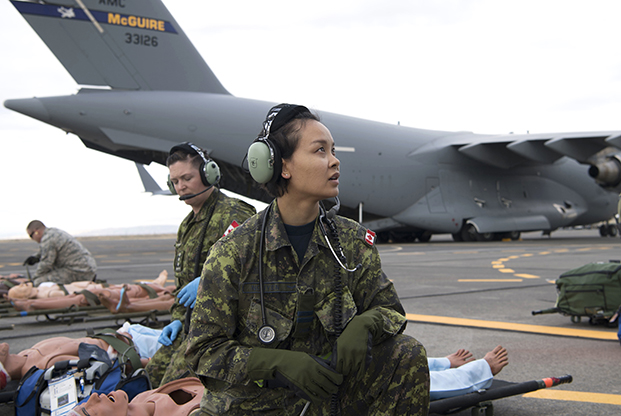
INTERNATIONAL FLAVOR
All told, Mobility Guardian included almost 40 international partners—either flying or observing or both. Early in the exercise, Fairchild’s ramp included Canadian C-130s and Royal Australian Air Force C-17s and KC-30 tankers flying alongside US airframes. Wing Commander Sarah Stalker, commander of the RAAF’s 33 Squadron and leader of the RAAF detachment at the exercise, said her service’s major goals were to fly in formation with US aircraft and experience using their Airbus-built KC-30 tankers to refuel aircraft they don’t usually get to practice with, especially smaller aircraft that use a boom as opposed to Australian fighters, which use a drogue system.
“The major goals for us, we’re looking at the interaction pieces and interoperability,” she said.
Among the opportunities: linking up two tankers with Air Force Global Strike Command B-52s for simulated strike missions.
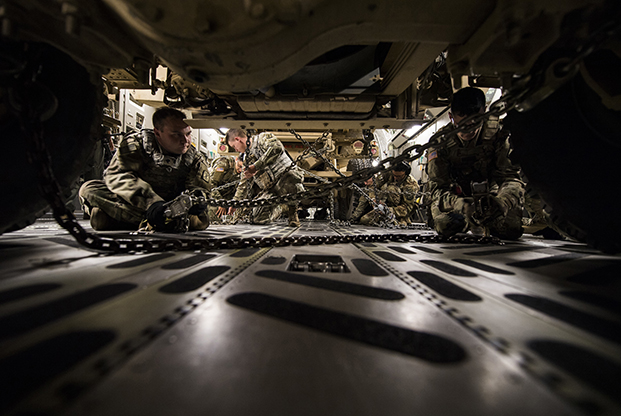
Throughout the exercise, Fairchild operated as if under threat, a scenario the Air Force hasn’t faced in real life for decades, but that would be the case for overseas bases in a real war with a peer rival.
Flying operations had to overcome degraded communications, with airmen at times serving as “runners” to simulate the loss of radio communications. Base’s security forces practiced warding off small drones and finding ways to be intimidating in order to protect a base cut off from bringing in reinforcements, said Col. Derek Salmi, the commander of the 92nd Air Refueling Wing at Fairchild. Salmi is also serving as the commander of the 621st Air Exercise Wing for Mobility Guardian.
AMC must be able to do “just do what we do every day,” but in a highly contested environment.
“We know the enemy is going to get to us” Miller said. “They’re going to get into our cyber domains, they’re going to mess with our cargo loads, going to mess with our crews. And it’s inevitable. A lot of the stuff we do is on the nonsecure side, on the NIPR [Nonclassified Internet Protocol Router] side of the DOD network, and we’ve talked about how to secure that.”
During the exercise, this meant air crews needed to know the commander’s intent for their missions and be confident and able enough to meet that intent without being in contact with that commander or the operations center.
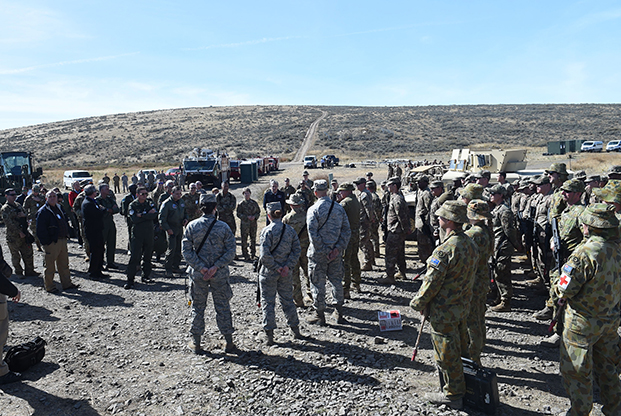
“If you’re on a mission and you lose connectivity back to the mother ship, back to that command and control element, do you continue, or do you not continue” Miller said. “We give—before you launch—as part of that mission planning, your commander’s intent. You will proceed. You will do this.”
In the midst of the exercise, Fairchild had to maintain current operations, such as having tankers standing alert, around-the-clock for homeland defense and strategic support. The base sent two tankers to nearby Spokane International Airport to stay on alert, with more personnel and aircraft sent to March ARB, Calif. Additional crews were deployed to Afghanistan and Incirlik AB, Turkey, as well as Operation Juniper Micron, a refueling mission operating out of Spain to support French operations in Africa.
Yet, the 92nd at Fairchild has about 2,900 personnel and 44 aircraft. At the peak of the exercise, it anticipated an additional 2,500 personnel and 43 aircraft, effectively doubling the overall force structure of the base. Clustered tents formed an “ops town” and a short line of local food trucks offered burritos, barbecued ribs, and macaroni and cheese as alternatives to field rations. The exercise’s headquarters, which connects via video teleconference to the AOC at Travis, is in the basement of the base’s post office.
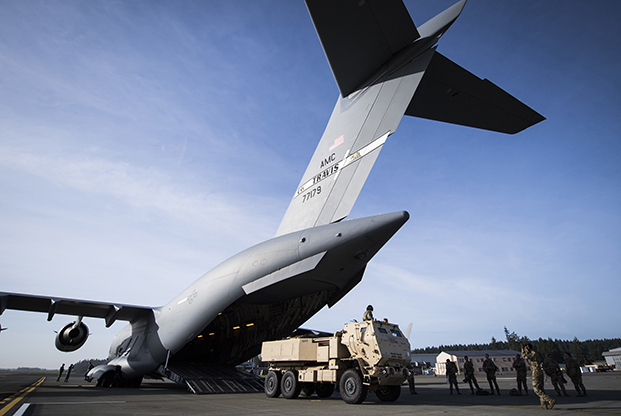
Mobility Guardian’s goal is to better prepare Air Mobility Command to fight in a world where the US may not be able to claim air dominance in combat zones or even on bases. AMC must therefore become more agile and flexible, such as adapting a location that usually only flies one mission set—tankers, in Fairchild’s case—to become the main operating location for every aspect of a combined force operation.
In Europe, for example, only Ramstein AB, Germany, has a heavy airlift presence, while tankers are well-represented at RAF Mildenhall, UK. In a conflict with another top-tier military, bases will need to be able to support more than their regular operations and do so facing possible jamming, cut-off communications, and other problems.
With Mobility Guardian, “we’ve basically erased that map,” said Lt. Col. Brett Fish, the lead planner for the Mobility Guardian office at Fairchild. “Anywhere you see US presence, we’ve proven flexibility and adaptability, and we can be whatever the commanders want us to be.”
AMC needs to be able to surge to a new location and “be able to sustain not only the mobility air forces, but the combat air forces,” Monaco said. The Air Force calls the concept “Agile Combat Employment,” and Mobility Guardian was framed so the command could practice handling the fuels, munitions, and other materiel that would be needed in a fight. Because in the real world, “Who’s going to be moving that stuff around? It’s us,” Monaco said.
AMC brought in portable fuel bladders to set up refueling operations as if they had no fuel infrastructure, something the command doesn’t usually practice. “We don’t get the hands-on training, so this is providing real-world readiness for our younger airmen,” said MSgt. Donovan Horning, the AMC/A4 fuels plans and readiness manager.
“Adversaries are going to try to disrupt our joint force employment and force flow to posture for major combat operations,” Monaco said. “How are they going to do that? They are going to deny, disrupt, degrade our intermediate staging bases and main operating bases. We know that. Especially the higher-end [adversaries] that have cruise missiles and all that type of stuff that can reach out and touch us.”
The world has changed. “We always just assume we’re going to be able to go into a permissive, big base,” Monaco said. “Those days are over.”
